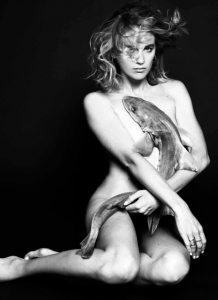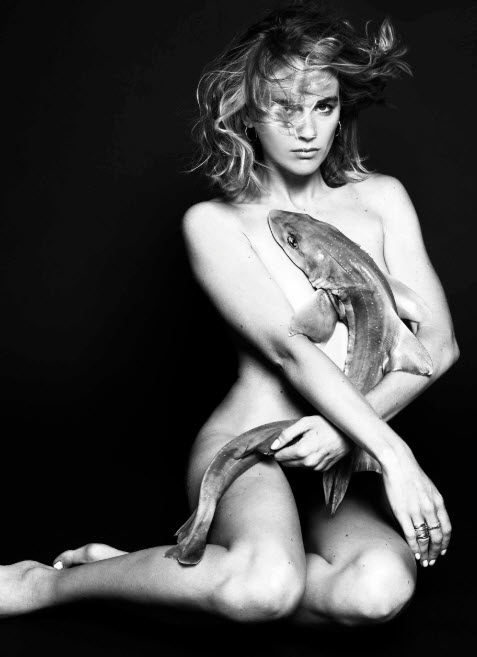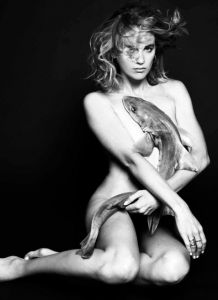Eat more fish: On day 4 of Seafood Week, BBC TV’s Breakfast programme featured a scheme undertaken by the charity Age UK to teach older men how to cook. Age UK say that older men grew up at a time when it was expected that the woman of the house would do all the cooking, so they never learnt any cookery skills at all. Now as they reach their eighties and nineties, these men find themselves living on their own or caring for a sick wife and unable to do even the basics in the kitchen. Age UK now run classes for these men who not only welcome the new skills but also the friendship of others with a similar experience. Age UK have also recruited well-known chefs to help, including Levi Roots, who taught a class in north London how to make jerk chicken.
We, at Callander McDowell, have previously argued that the fish and seafood industry should be undertaking a similar role teaching groups of less well-off families, who typically never eat fish and seafood, how to cook fish, whether it be simple dishes using tinned fish and seafood or some of the cheaper fresh fish and seafood that is available. These classes could be organised through the many charities that work in this sector, using fish donated by the fish sector. It is easy to tell people that they should be eating more fish but turning this message into actual consumption is a totally different question.
October 5th saw the start of the latest Seafood Week promotion. The week began with coverage in the mainstream press, such as the Mirror, the Express and the Metro. The article in the Mirror was typical with a headline of ‘We need fish quota boost’. The article stated that ‘Two thirds of us are not eating the recommended two portions of fish a week, a survey suggests. Around 74% also do not know how much seafood they should eat while 55% would like to eat more. Industry body Seafish’s poll marks Seafood Week, which is backed by the British Heart Foundation. Seafish’s Debbie Cook said: We’re lucky to have access to an abundant supply of fresh seafood and it’s a shame so many aren’t making the most of it.’
We don’t believe that this media coverage will persuade anyone who doesn’t eat fish and seafood to even consider doing so unless perhaps they have heart problems. We accept it is so easy to be a critic, but the reality is that Seafood Week promotions ran for a number of years before being dropped, and then returned in 2015. Despite all this effort, fish and seafood consumption continues to decline and as the latest Seafish poll shows, 68% of consumers say that they are not eating the recommended two portions of fish. Seafood Week is possibly not working.
Of course, we know our view will not be shared by others and Seafood Week will be declared a great success with increased media coverage with a reach to millions of potential consumers. This will have increased this year due to the inclusion of a radio advert on Classic, Heart and Smooth. Whether this will persuade consumers is unclear because when we heard it, we couldn’t actually make out all the words despite repeated listens on listen again.
‘Seafood Week is now on and there is no ‘plaice’ we’d rather be. Fresh, fast and fried, Shellfish something and sashimi. Seafood Week is now on until Oct 12th and its off the hook so don’t ‘mull it’ over. Change the way you ‘see food’. Seafood Week is now on until Oct 12th. If you miss it you something, something. Recipes and updates at Seafoodweek.co.uk
Seafood Week was also advertised on posters on the back of buses in some towns. One youngster we know said on seeing the ad that she couldn’t read the small print!! Adverts have also appeared on London Underground.

One of the first activities in Seafood Week was the ‘popular’ social media campaign #punday. Even the Sun newspaper had a go with three puns; ‘Are those pollocks’, ’Your plaice or mine’ and ‘Oh cod they’re naked.’ The last one referred to coverage of the Fishlove campaign in which celebrities have their photo taken naked with a fish. The campaign highlights an environmentally catastrophic decline in fish stocks. The celebrities featured include Cressida Bonas (Prince Harry’s ex), Paris Jackson and Elizabeth McGovern.

In all the newspapers much more space was devoted to ‘Fishlove’ than to Seafood Week so it is possible that if readers received any message, it was to eat less fish. This was an unfortunate coincidence.
Of course, newspapers are going to devote more space to pictures of naked celebrities than they are to the benefits of eating fish and seafood. However, we do think that the health aspect is one which is a turn off to consumers. This can be illustrated by the Twitter Takeover on Oct 8th. Fish is the Dish organised a Twitter Q&A with Juilette Kellow a nutritionist that ran for an hour from 7pm. Although 12 questions were posed to Juilette during the hour, not one was asked by a member of the public. All the questions were posed by the Fish is the Dish team and these included ‘Will seafood help protect me against coughs and colds this autumn/winter? and ‘Can seafood help me control type 2 diabetes?’ It seems that fish and seafood is been promoted almost as a remedy rather than a tasty food. Is the fishmonger the new pharmacy?
We have previously mentioned that this year we had hoped to experience Seafood Week in a participating restaurant. The Seafood Week pages on Fish is the Dish listed about 210 campaign partners but as we ran through these it was apparent that the partners were a mix of retail, processors, fish and chips shops and restaurants. Eventually, we identified two partners that we could try. The first was Holiday Inn hotels and we visited the new central Manchester one lunch time. Unfortunately, there was no Seafood Week promotion or any related offer available. The second partner was the Hip Hop Chip Shop, who we have previously mentioned. Hip Hop operate a pop up at Media City and on the day we visited, the sun was out and the area thronged with people. Unfortunately, although other pop ups were doing good business, Hip Hop was closed and we don’t know why.

The question for us is whether the ongoing decline in fish consumption can be reversed. The Seafood Week page on the Seafish website states that sales of fish and seafood increased by 8.3% as a result of the 2017 Seafood Week promotion compared to the previous year. Sales increased from £133 million to £143 million but no mention is made of changes in volume. Increased fish prices alone could account for this increase in sales, yet, overall consumption could have gone down.
Any increased sales are most likely to come from those people who already eat fish. It is easier to persuade consumers to eat three portions rather two, than it is to get those who never eat fish to eat one. Yet consumers visiting fish counters and chilled shelves in any retail store will have not seen any indication that it was Seafood Week. Not one store we visited carried any reference to Seafood Week at all. We believe that Iceland distributed a flyer with a mention of Seafood Week but we didn’t see it in store. The small north west England retailer Booths increased the number of fish on promotion during the week but there was no reference to Seafood Week. Booths did refer to it on their website along with a competition organised by their supplier to win a whole salmon. They also tweeted the link.
As we already pointed out, we know it is very easy to criticise but at the same time, we have observed every recent Seafood Week (or fortnight) promotion and none have never really brought about a change in consumption. Perhaps it is time for a change.
Pollocks: The Guardian reported that the Marine Conservation Society (MCS) are urging consumers to eat more pollock and less squid in an attempt to alleviate pressure on threatened stocks. The latest updates to the MCS Good Fish Guide recommend which are the best fish to eat in terms of sustainability.
The conservation charity says that choosing sustainable seafood is a complex issue not helped by a lack of clear labelling. The lack of information means that consumers need all the help they can get. The charity says that using the Good Fish Guide will point consumers in the right direction and start the sustainability conversation. We, at Callander McDowell, bought a copy of the Good Fish Guide in 2002 and we are still waiting to have that conversation. This is because no-one seems that interested and its not surprising. If a fish is on the menu of a restaurant or on a fish counter and consumers ask ‘is that sustainable’, as the MCS suggests, we know what the answer will be. The fact is that no-one really knows whether fish are sustainably fished or not and that includes the MCS.
The general view within the fish and seafood industry is that one of the best measures of whether a species is sustainable is if it is certified by the Marine Stewardship Council (MSC). Some would not agree but that is not the issue here.
The Guardian printed a list of the best and worst rated fish by the MCS. Unfortunately, they mistakenly wrote that it was the MSC’s list, which shows how easy it is to get confused on this contentious issue. The best choice are fish and seafood that are rated ‘1’ by the MCS and the worst are those rated ‘5’. Of the six best choices, the Guardian has identified that three are MSC certified.
The list as it appeared is:
Pollock – Alaska/Walleye
Native oysters (sail and oar)
European hake (gill or fixed)
Herring/sild (MSC certified)
Coley/saithe (MSC certified)
Haddock (from Rockall or MSC certified)
We are not sure if these are in any order but as the Guardian headline is to eat more pollock, we will start by looking at this fish. The first thing that the Good Fish Guide says is that if you like cod or haddock, you will like Alaska pollock. They say to choose MSC certified Alaska pollock yet, their best choice list fails to mention that this species is MSC certified. However, it seems that not all Alaska pollock is certified since the rating given to the fish is 1 to 5. The guide details four fisheries from which the consumer can choose.
The first two are around Alaska, Bering Sea and the Aleutian Islands. These are rated ‘1’ and are MSC certified. The third option are fish caught in the Okhotsk Sea which are also MSC certified. These are rated ‘2’ but it is not clear what the difference is between these fisheries given that they are all MSC certified. The final fishery is the Western Bering Sea and is rated ‘5’ and is not certified. It seems that these Alaska pollock far from being a best choice are fish to avoid.
The Good Fish Guide helpfully provides a list of alternatives for fish with a low rating. These are Basa, farmed sea bass, farmed sea bream, Atlantic cod, Pacific cod, Coley/saithe, haddock, European hake, Alaska pollock, farmed sturgeon, tilapia and whiting.
The impression we have is that MCS suggest that we should eat Alaska pollock as an alternative to popular species such as cod to alleviate the pressure on (threatened) stocks. The Good Fish Guide lists 33 options for cod. These are rated ‘1’ to ‘5’. These include stocks of cod caught in Iceland – three options all rated ‘1’. These include cod caught by longline and demersal otter trawl but also gill net. The first two methods are certified by the MSC, the gill net fishery isn’t, yet it is still rated ‘1’ by the MCS.
Fish caught by trawl in the Norwegian Sea are rated ‘2’. These include fish that are certified by the MSC and fish that are not.
There are a number of cod fisheries that are rated ‘3’ by the MCS, one of which is that of the North Sea, eastern English Channel and Skagerrak. This fishery is certified by the Marine Stewardship Council.
This means that the MCS has rated different MSC certified fisheries as ‘1’, ‘2’ and ‘3’. The MCS say fish rated as ‘3’ should not be considered sustainable. Perhaps they should tell the MSC.
Its no wonder that consumers switch off to the issue of sustainability. We have written before that we don’t consider the MCS to be consumer friendly and our view has not changed. They are completely out of touch with the consumer market, not least because whilst it is easy to suggest converting consumers to Alaska pollock, we challenge the MCS to tell us where we can buy some fresh Alaska pollock. By comparison, we can tell them hundreds of outlets that sell fresh cod.
However, the biggest challenge will be to find fresh farmed sturgeon anywhere. MCS may consider it sustainable but it is also unavailable. Maybe that’s why it is a good choice.


